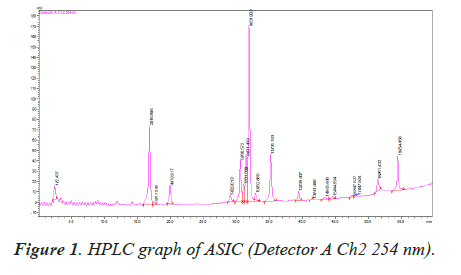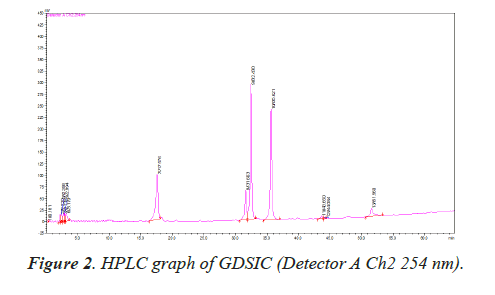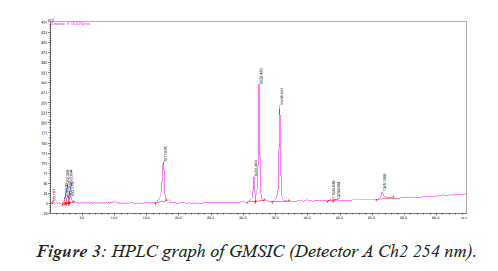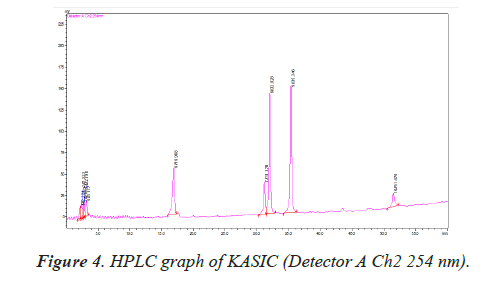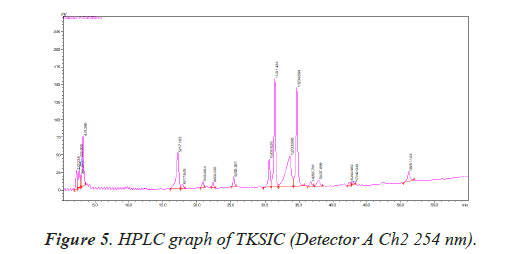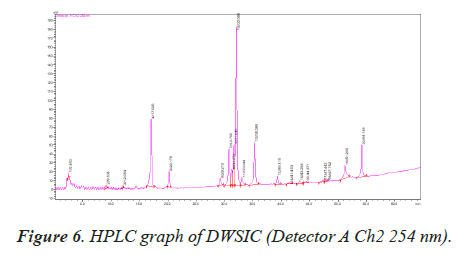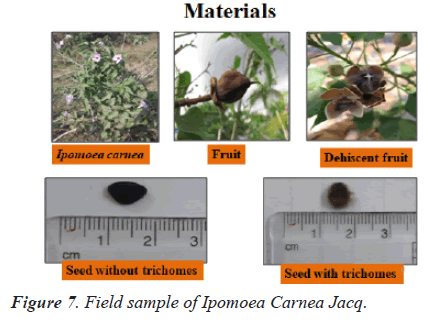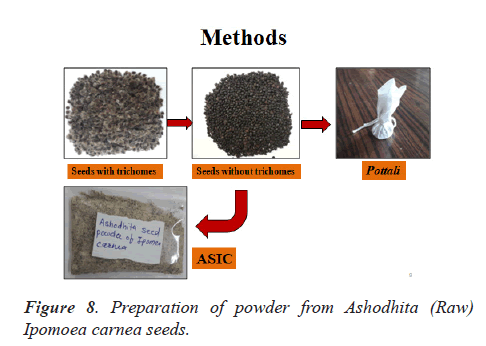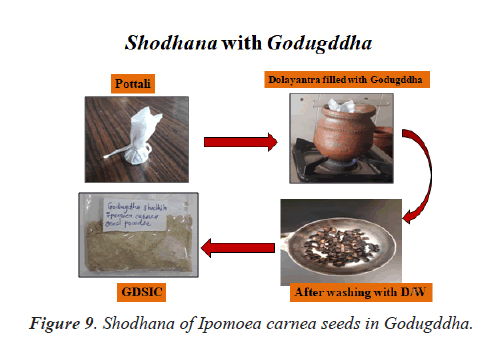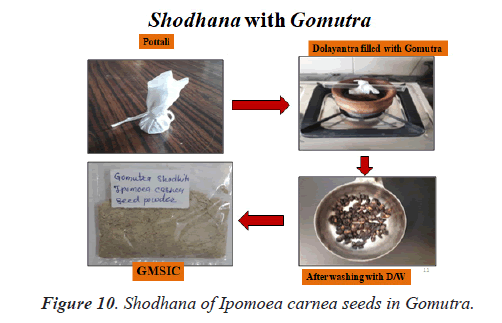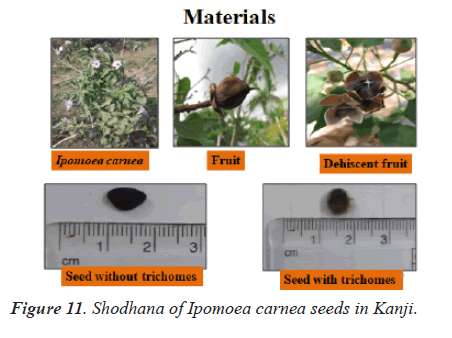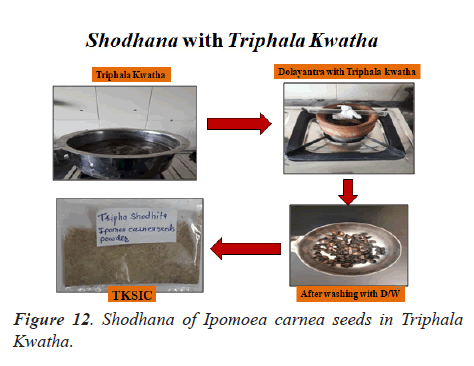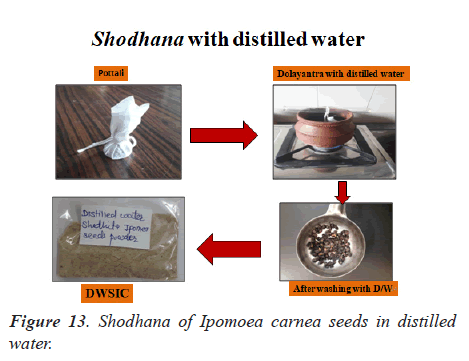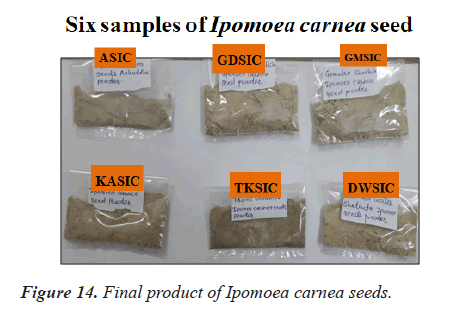ISSN: 0970-938X (Print) | 0976-1683 (Electronic)
Biomedical Research
An International Journal of Medical Sciences
Research Article - Biomedical Research (2021) Volume 32, Issue 4
Comparative phytochemical assessment of Ashodhita and Shodhita seeds of Ipomoea carnea Jacq (An ethno pharmacological drug).
Nilima Wadnerwar1*, Meena Deogade2
1Department of Agadtantra, Mahatma Gandhi Ayurved College, Hospital and Research Centre, Salod (H), Datta Meghe Institute of Medical Sciences (DU), Wardha, Maharashtra, India
2Department of Dravyaguna, All India Institute of Ayurveda, New Delhi, India
- Corresponding Author:
- Nilima Wadnerwar
Department of Agadtantra
Mahatma Gandhi Ayurved College
Hospital and Research Centre
Maharashtra, India
Accepted July 19, 2021
Background: Ipomoea carnea Jacq is an ethnopharmacological drug and its leaves, roots and latex are used for various indications by traditional healers. But seeds are not used in the treatment as they are more toxic. As the herbal medicines are becoming endangered, ethnopharmacological drug can be used efficiently as they are available abundantly. But the toxicity should be reduced for safer use in the treatment. To study the effect of Shodhana of Ipomoea carnea seeds and to study the physicochemical and phytochemical changes in seeds after shodhana in different media, the present study was undertaken.
Methods: Shodhana of 20 gm of Ipomoea carnea seeds was performed with Godugdha (Cow’s milk) with the help of method of swedana (boiling) in dolayantra for three hours. The same procedure was followed for another samples separately with Gomutra (Cow urine), Kanji (sour gruel), Triphala kwatha and Distilled water as shodhana media. One raw sample was kept as Ashodhita sample for comparison. Physicochemical and phytochemical analysis of all the six samples was conducted and the observations were compared among all the samples.
Results: The toxic principle Swainsonine was estimated as 3% in all samples at retention time 3 minutes. The number of peaks were reduced in Godugdha, Gomutra, Kanji and Triphala Kwatha Shodhita samples in comparison with Ashodhita sample and 2-4 peaks are observed at retention time 1-3 minutes in all shodhita samples. A new phytoamine having concentration 12% was detected at retention time 17 minutes in all (crude and purified) samples.
Conclusion: The number of peaks was reduced in shodita samples which may be due to antagonist action of shodhana media and 2-4 peaks are found in all shodhita samples which may be added due to the antidotal action of shodhana media. A new phytoamine detected at retention time 17 minutes in all samples needs to be identified and characterized using more advance tools like LC-MS or GC-MS.
Keywords
Ipomoea carnea, Ethnopharmacology, Shodhana, Swainsonine
Introduction
Ethnopharmacology is a scientific approach to the study of the biological activities of any preparation used by humans which are either beneficial or toxic. It includes the combined broad anthropological, pharmacological and toxicological study of these preparations [1]. In India traditional medicines have been used since long ago. In pharmacopoeia and other scientific databases, all such herbal and toxic medicinal drugs are included with their pharmacokinetic, pharmacodynamic and toxicokinetic information. But some of them are still not included in scientific databases whereas they are used actively for therapeutic purposes as folklore medicine in remote areas. Many claims have been made by traditional healers for ethanomedicine. Very few scientific researchers are available exploring their pharmacokinetic, pharmacodynamic and toxicokinetic information. Hence, it is very much essential to study these medicines scientifically as there is a need of validation and to generate the evidences regarding the claims.
Ipomoea carnea Jacq is a species of morning glory belonging to Convolvulaceae family and commonly known as Besharam in Maharashtra meaning shameless due to its rampant spreading. It is a locoweed. It has medicinal value and is used as folk medicine [2]. Leaves are used as purgative. Paste of leaves is applied on a sore known as ‘Haja’ which occurs in between toes and fingers due to fungal infection. Leaves are cooked and eaten as a vegetable even though they are slightly purgative. Roots have laxative effects and are boiled and used to provoke menstruation, and are traditionally a treatment for skin diseases. Latex or Milky sap of plant has been traditionally used to treat Leucoderma [3] in Chhattisgarh, India and other related skin diseases. The latex of plant applied locally to relief boils and pimples in the body skin, used locally to alleviate the stomach ache, nodules in breast, muscular pain and swelling. Latex is also used as an antiseptic in skin diseases. Stem juice is used as an antiseptic in cuts and injuries [4]. Leafy latex of Ipomoea carnea are already reported the presence of flavonoid and evaluated for wound healing activity [5]. It contains a component identical to marsilin which is used as a sedative and anticonvulsant [6]. It also contains a glycosidic saponin which has anticarcinogenic and oxytoxic properties [7]. Ash of Ipomoea carnea leaves was used in a skin disease in some rural areas of Chhattishgarh, India [2]. Extract of the whole plant prepared in hot water was widely used as anti-rheumatic remedy in Bolivia [8]. The plant is also believed to reduce the teratogenic effect of cyclo-phosphamide [9]. In many folk medicines, it is used as aphrodisiac, purgative as well as cathartic [10]. From the field survey in Wardha district of Maharashtra state in India, it came to know that its leaves are used for scorpion bite. The fresh leaves are crushed and its juice is poured on bite site. The paste of leaves is applied and kept over bite site till the pain subsides.
The Swainsonine is the main toxic principle present in Ipomoea carnea. Leaves and flowers of Ipomoea carnea contain Swainsonine, Calystegines B1, B2, B3 and C1 along with other phyto constituents [11]. But seeds contain only Swainsonine, Calystegines B1, B2, B3 and C1 and are not used as medicines because of its highly toxic nature. Seeds and leaves are toxic and it can be hazardous to cattle, the toxicity is related to the bioaccumulation of selenium species in leaves but mostly in seeds [12].
Swainsonine is water soluble and hence it distributes rapidly in many parts of the body. It is excreted rapidly through urine. The fast excretion rate indicates that occasional consumption of the locoweed for short duration will not produce serious toxic effects but continuous consumption even at low dose causes severe toxicity. Swainsonine from locoweed causes acute intoxication in horses, goats, and sheep, in addition to chronic poisoning in rabbits, rats, and mice. Consumption of these plants leads to a chronic wasting disease characterized by weight loss, depression, altered behavior, decreased libido, infertility and death [13].
Consumption of the seeds may cause negative side effects, including vomiting, nausea and indisposition; probably as a result of non-water-soluble alkaloids. Visions of “small people” are very common, as well as LSD-like sensations, although the effects are not exactly like LSD. The seeds also seem to stimulate the uterus, probably due to the alkaloid ergonovine [14].
Due to the deforestation and changing climatic conditions, a wide number of species of medicinal plants are getting endangered whereas in India, Ipomoea carnea grows naturally in waste lands, wet land, roadside, canals and drain banks abundantly. Swainsonine has antitumor activity in advanced malignancies [15]. Though the species is used as folk medicine, no scientific work has been conducted to evaluate the efficacy or to evaluate the toxic potential of Ipomoea carnea seeds. The drug is toxic but no antidote is available for its toxicity. Hence, the only thing is to reduce the toxic effect of seeds to use it in the treatment. It can be used after shodhana methods of purification mentioned in Ayurveda. By using the principle of shodhana of toxic drugs described in Ayurveda, an attempt has been made to observe the effect of shodhana on seeds of Ipomoea carnea and to study the physicochemical and phytochemical changes in seeds after shodhana in different media with the help of advanced techniques like HPLC so that the drug can be used without any toxic effect.
Materials and Methods
Experimental analytical study was conducted after receiving IEC Approval Ref No. DMIMS (DU)/IEC/Dec- 2019/8629 dated: 21/12/2019.
A field survey was conducted in the area surrounding Sawangi (Meghe), Salod (Hirapur), Deoli, Pulgaon, Paloti in Wardha district. Plant and seeds of Ipomoea carnea Jacq was identified and collected. It was authenticated from Foundation for Revitalization of Local Health Traditions, Bangalore. (FRLHT Col.No.123415 dated 29th May 2020). Fully matured, self-dried fruits of Ipomoea carnea were collected and seeds were separated from dried fruits. Physical impurities as well as trichomes (fur) attached with seeds were also removed. Fully matured black colored seeds were selected for the study. Weight, breadth and length of the fully matured single seed were recorded.
Shodhana (Purification) of Ipomoea carnea seeds
Ipomoea carnea seeds were divided in six groups each containing 20 gm. One sample was kept as Ashuddha (unpurified/untreated) sample and it was powdered finely. Five pottali (sac) were prepared with double layered cotton cloth and 20 gms Ipomoea carnea seeds in the centre of the cloth which were tied properly. The pottali was hanged and suspended in the earthen pot filled with Godugddha (cow milk) with the help of thread and glass rod kept horizontal on the mouth of the earthen pot. Dolayantra thus prepared was kept on low flame to boil Godugddha for three hours. After every half an hour, Godugdha was added to maintain the level so that the pottali should be dipped properly into the liquid. After three hours, potalli was removed and allowed to cool. After cooling, it was opened and washed once with distilled water. It was then allowed to dry at room temperature for two days. After proper drying, the drug was finely powdered and stored in airtight containers. Total quantity of Godugdha required was noted at the end of the shodhana. The same procedure was followed with Gomutra (Cow urine), Kanji (sour gruel), Triphala kwatha and Distilled water with the help of method of swedana (boiling) in dolayantra for three hours. Every time new earthen pot and new cloth for pottali was used to avoid contamination from each other for physicochemical and phytochemical analysis. All the groups were labelled as follows:
• ASIC-Ashodhita seeds of Ipomoea Carnea
• GDSIC-Godugdhha (Cow milk) Shodhita seeds of Ipomoea Carnea
• GMSIC-Gomutra (Cow urine) Shodhita seeds of Ipomoea Carnea
• KASIC-Kanji (sour gruel) Shodhita seeds of Ipomoea Carnea
• TKSIC-Triphala Kwatha Shodhita seeds of Ipomoea Carnea
• DWSIC-Distilled Water Shodhita seeds of Ipomoea Carnea
Analytical study of Ipomoea carnea seeds
All the six samples were subjected to physicochemical analysis in which Moisture content, Total Ash Value, Water soluble Ash value, Acid insoluble ash value, Water extractive values, Alcohol extractive values, pH, Sieve analysis for particle size and Microbial examination was conducted. In Phytochemical analysis, High Performance Liquid Chromatography (HPLC) was conducted.
Phytochemical analysis: HPLC (High Pressure Liquid Chromatography)
Procedure of HPLC
Exactly 700 mg of each sample was weighed and diluted with 1 mL of IPA, 2 mL of water and 1 mL of methanol. These samples were heated at 60ºC for 5 minutes to assure complete dissolution of all components. Furthermore, they were sonicated and then filtered through 0.45 uL nylon filters. 20 uL of each sample was then analysed using HPLC instrument.
Chromatographic analysis was performed with Shimadzu Prominence HPLC instrument. It is equipped with quaternary pump, (LC20-80) degasser (DGU-20As) column oven (CTO-10As) Auto sample (SIL-20AC) Diode-Array-Detector (UVSPD-M20). Phytochemical were analyzed with Prime SIL C18 column (250 × 4.6 mm. ID).
Chemicals
HPLC grade methanol and water were used for HPLC analysis. They were purchased from Merck (Mumbai MH. India), HPLC grade ammonium acetate was purchased from Sigma-Aldrich (Mumbai MH, India). 0.2 μ sample filters and 0.45 μ nylon solvent filters were purchased from Milipore, India. Sample sonication was performed in Labman sonicator, purchased from Multilab, Ltd, Chennai, India.
Methodology
Extraction of sample: Exactly 20 g of weighted sample 1 ASVTK in powder form was dissolved in 20 ml of ethanol. Same procedure was carried out with the sample 2, 3, 4, 5 and 6. All the six samples were kept for 24 hrs at room temperature to improve the release of all potential components. Furthermore, all six samples were ultra sonicated for 30 minutes and filtered through 0.2 μ nylon sample filters.
HPLC analysis: 20 ul of freshly prepared stock solution of sample 1 ASVTK was injected to the C18 column (200 × 46 mm) and eluted at the flow rate of 1.5 ml. min-1. Binary composition of methanol and water including ammonium acetate (50 Mm) were employed throughout the HPLC analysis. 254 nm UV wavelength and ambient temperature were considered for achieving better peak shape and peak area. The same procedure was carried out with the sample 2, 3, 4, 5 and 6. All the samples were separately analyzed and graphic analysis report was obtained.
Results
Table 1 shows the observations of physicochemical analysis and the results of phytochemical analysis are shown in Figures 1-6 as HPLC graph of various groups were labelled.
| S. No. | Analytical parameter | ASIC | GDSIC | GMSIC | KASIC | TKSIC | DWSIC |
|---|---|---|---|---|---|---|---|
| 1 | Moisture content at 105ºC | 0.54 | 0.72 | 0.41 | 0.68 | 0.51 | 0.32 |
| 2 | Total ash value | 5.33 | 6.27 | 6.27 | 6.82 | 5.97 | 4.29 |
| 3 | Water soluble ash value | 2.98 | 3.11 | 3.12 | 4.87 | 2.81 | 1.78 |
| 4 | Acid insoluble ash value | 0.5 | 0.5 | 0.5 | 0.5 | 0.5 | 0.5 |
| 5 | Water soluble extractive value | 42.61 | 43.72 | 38.82 | 31.73 | 31.61 | 41.83 |
| 6 | Alcohol soluble extractive value | 22.71 | 29.12 | 26.88 | 26.90 | 41.72 | 24.27 |
| 7 | pH | 5.2 | 5.1 | 5.4 | 4.6 | 5.0 | 4.9 |
| 8 | Particle size (by sieve analysis using 80 No. mesh) | 100% | 100% | 100% | 100% | 100% | 100% |
Table 1. Showing observations of physicochemical analysis.
Discussion
Ayurveda has described the use of poisonous drugs in the form of herbal, mineral and herbomineral formulation in the treatment only after shodhana in order to reduce the untoward effects of the drug, to reduce the toxicity and to potentiate the action of drug in small doses. Common and specific media are mentioned for the process of shodhana. Using the same principle of shodhana, it was decided to assess the effect of shodhana on the level of toxic principle Swainsonine present in Ipomoea carnea Jacq seeds using common method of swedana (boiling) in Dolayantra (made up of earthen pot) with common media like Godugddha (Cow milk), Gomutra (Cow urine), Kanji (fermented Sour gruel), Triphala Kwatha (decoction of Embelica officinalis, Terminalia chebula, Terminalia belerica) and distilled water for comparison. After shodhana, all the samples were analyzed with the help of physicochemical and phytochemical analysis (HPLC).
All the six samples of Ipomoea carnea seed were blackish cream in colour. All the physicochemical parameters are within normal limit. The moisture content was more in sample GDSIC (0.7) in comparison with other four samples. It may be due to the fat content of the cow milk. Total ash value (6.82) and water soluble ash value (4.87) are more in KASIC sample in comparison with ASIC and all other samples. Acid insoluble ash value is same (0.5) in all the samples. It indicates that the samples are soluble in gastric juice and heavy metal content is absent. So absorption of Ipomoea carnea seed powder in body will be better. Water soluble extractive values of all the six samples are high indicating that they are more water soluble and organic. Water soluble extractive value is decreased in TKSIC sample (31.61) in comparison with ASIC (42.61). It is increased in GDSIC sample (43.72). Alcohol soluble extractive values of all the six samples are also high indicating that all the samples are soluble in alcohol. Alcohol soluble extractive value is increased in TKSIC sample (41.72) in comparison with ASIC (22.71). All the samples of Ipomoea carnea seed are acidic in nature but samples KASIC and DWSIC are found more acidic with pH 4.6 and 4.9 respectively in comparison with ASIC (5.2) sample. Powder of all the samples was fine enough to pass through a mesh of size 80. 100% particles of all the samples passed through this mesh (Figures 7-14).
In HPLC, the peak of Swainsonine was detected at retention time 3 minutes and it was estimated as 3% in all the samples. A new phytoamine has been detected at retention time 17 minutes in all (crude and purified) samples and it was estimated as 12%. The peaks of tanic acid and galic acid were found and estimated as 9% in all samples. The flavonoids viz Rutin Myrecetin and Quercetin were detected as 65% in all samples. Quercetin is responsible for wound healing. 11% unclassified terpenoids were detected only in Ashodhita sample. Total 19 peaks were observed in Ashodhita sample, 13 peaks were observed in GDSIC, 14 in GMSIC, 10 in KASIC, 18 in TKSIC and 20 in DWSIC at wavelength 254 nm. Peaks from sample GDSIC, GMSIC, KASIC are decreased. It may be due to the antagonism action of shodhana media over some poisonous compounds. 2-4 peaks are observed at retention time 1-3 minutes in GDSIC, GMSIC, KASIC and TKSIC samples. It may be due to antidotal action of shodhana media. The extinct components may be terpenoids which are not found in all shodhita samples. Hence, this shodhana procedure may be helpful to reduce the harmful effect of Ipomoea carnea seeds.
A new phytoamine has been detected at retention time 17 minutes in all (crude and purified) extracts which was not characterized or reported in any other previous researches found on free accessed search engines. However, after comprehensive subject exploration, no any articles have displayed the HPLC report to understand the separation pattern and the location of constituents in Ipomoea carnea seed. Hence, there is a need to characterize the presence of the new phytoamine using more advanced tools like LC-MS/MS. Major advantage of this HPLC analysis is that no any published article has yet displayed the chromatographic views of Ipomoea carnea.
In the present study, the toxic principle Swainsonine was estimated as 3%. In a previous study, it was reported that levels in excess of 0.001% of swainsonine may cause toxicity in animals [16].
Conclusion
It indicates that the seeds of Ipomoea carnea are very toxic in small doses. Toxicity study of all the (crude and purified) samples of Ipomoea carnea seed is recommended in animals to evaluate the effect of shodhana on the toxic principle swainsonine and to confirm the toxic effects of Ashodhita and shodhita samples of Ipomoea carnea seed. In the present study, the number of peaks were reduced in Godugdha, Gomutra, Kanji and Triphala Kwatha Shodhita samples in comparison with Ashodhita sample which may be due to antagonist action of shodhana media and 2-4 peaks are observed at retention time 1-3 minutes in all shodhita samples which may be added due to the antidotal action of shodhana media. There was no such effect of distilled water as shodhana media.
Conflict of Interest
None
Funding Source
Datta Meghe Institute of Medical Sciences (deemed to be University), Wardha, Maharashtra, India.
References
- Heinrich M, Edwards S, Moerman DE, Leonti M. Ethnopharmacological field studies: a critical assessment of their conceptual basis and methods. J Ethnopharmacol 2009; 124: 1-17.
- Agarwal RK, Upadhyaya RK. Preliminary pharmacological studies on the glycoside obtained from the Ipomoea carnea Jacq. Indian Drugs Pharma 1978; 13: 7-8.
- Adsul VB, Khatiwora E, Torane R, Deshpande NR. Antimicrobial activities of Ipomoea carnea leaves. J Nat Prod Plant Resour 2012; 2: 597-600.
- Dash SS, Mishra MK. Tribal uses of plants from Narayanapatna region of Koraput district, Orissa. Anc Sci Life 1996; 15: 230-237.
- Ambiga S, Narayanan R, Gowri D, Sukumar D, Madhavan S. Evaluation of wound healing activity of Ipomoea carnea Jacq. Anc Sci Life 2007; 26: 45-51.
- Meira M, Silva EP, David JM, David JP. Review of the genus Ipomoea: Traditional uses, chemistry and biological activities. Brazil J Pharmaco 2012; 22: 682-713.
- Sharma A, Bachheti RK. A review on Ipomoea carnea. Int J Pharm Bio Sci 2013; 4: 363– 77.
- Shaltout KH, Al-Sodany YM, Eid EM. The biology of egyptian woody perennials 2. Ipomoea carnea Jacq. Ass Univ Bull Envirin Res 2006; 9: 75-90.
- Phillips O, Gentry AH, Reynal L, Wilkin P, Gulvez DCB. Quantitative Ethnobotany and Amazonian Conservation. Conser Bio 1994; 8: 225-248.
- Ved GA, Kinhal K, Ravikumar MK, Vijaya S, Indresha JH. Threat Assessment and Management Prioritization for Medicinal Plants of Chattisgarh and Madhya Pradesh. Bangalore: FRLHT, 2004: 418.
- Balogh KK, Dimande AP, van der Lugt JJ, Molyneux RJ, Naude TW, Welman WG. Lysosomal storage disease induced by Ipomoea carnea in goats in Mozambique. J Vet Diagn Invest 1999; 11: 266-273.
- Nusrat F, Mohammad MR, Khan MA, Junjiang Fu. A review on Ipomoea carnea:Pharmacology toxicology and phytochemistry. J Complementary Integr Med 2014; 11: 55-62.
- Hueza IM, Fonseca. Evaluation of immunomodulatory activity of Ipomoea carnea on peritoneal cells of rats. J Ethopharmacol 2003; 87: 181-86.
- Gaur LB, Singh SP, Gaur SC, Saxesena RR, Parveen S, Kumar S. Facts with therapeutic significance of Ipomoea carnea. Punarnav 2014; 2: 141-146.
- Paul EG, Jose B, Berny F, Michael B, James WD. A Phase I Study of Swainsonine in Patients with Advanced Malignancies. Cancer Res 1994; 54: 1450-1457.
- Molyneux RJ, James LF, Ralphs MH, Pfister JA, Panter KP, Nash RJ. Polyhydroxy alkaloids glycosidase inhibitors from poisonous plants of global distribution: analysis and identification. CAB International 1994: 107-112.
